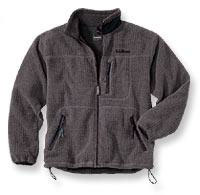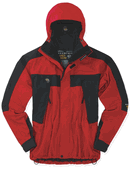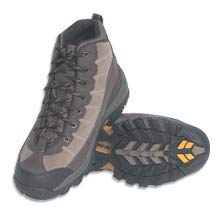|
Winter
photography has some serious advantages. Beyond the visual spectacle of
nature in winter, is the fact that there are just less people to get in the
way. Places that will be packed with humans during the summer months will
be virtually deserted in winter. The more uncomfortable the conditions, the
more likely you are to have it all to yourself. Iíve been on deserted
beaches at sunset without even a boat to spoil the scene. At moments like
that, you swear that sunset must have been custom made just for you!
I live in
New England, so that means its cold six months out of
the year, and really, really cold for three of those, so good outerwear is a
must. Winter photography has some special demands. You need to be able to
move freely over perhaps difficult terrain while carrying heavy loads.
Maybe for long distances. Then set up for a shot and wait, immobile, until
the light is perfect. So your clothing needs to protect you during physical
activity and the totally opposite condition of remaining stationary. Most
importantly, it has to keep you dry. Getting wet can literally kill you,
and this includes perspiration from the aforementioned physical activity.
Youíve
heard it a million times, and for a reason, but the key is layers, layers,
layers. And the RIGHT layers too. Letís get one thing straight, as
comfortable as it is, cotton is a lousy layering material. Remember all
those times you had a sopping wet cotton t-shirt? Or moved around a little
bit in your street clothes and your t-shirt got damp and took hours to dry
out?
Cotton absorbs moisture, but doesnít
breathe readily or dry out quickly. Start with one of the high tech base
layers like polypropylene, which are available from a number of outdoor
suppliers.
 The
mid layer should be a jacket made of Polartec fleece. It comes in different
weights, designated 100, 200, and 300, with 300 being the thickest. Fleece
breathes well, dries quickly, and provides terrific warmth versus weight.
Since you got it in a jacket, you can adapt to the weather conditions by
zipping up to your neck in the cold, or opening up if it gets warmer.
Polartec jackets also can be used by themselves under dry conditions and
sometimes come with an outer layer or treatment to repel wind and/or water.
You can get them a lot of suppliers. I personally like the Grid Fleece
jacket from L.L. Bean, but L.L. Bean is not the company it once was. The
customer service is a shadow of what it was in years past, and my last
ordering experience with them was very, very poor. They had problems
processing my order which I had to straighten out for them, then they
shipped a full week later than originally promised without explanation. The
mid layer should be a jacket made of Polartec fleece. It comes in different
weights, designated 100, 200, and 300, with 300 being the thickest. Fleece
breathes well, dries quickly, and provides terrific warmth versus weight.
Since you got it in a jacket, you can adapt to the weather conditions by
zipping up to your neck in the cold, or opening up if it gets warmer.
Polartec jackets also can be used by themselves under dry conditions and
sometimes come with an outer layer or treatment to repel wind and/or water.
You can get them a lot of suppliers. I personally like the Grid Fleece
jacket from L.L. Bean, but L.L. Bean is not the company it once was. The
customer service is a shadow of what it was in years past, and my last
ordering experience with them was very, very poor. They had problems
processing my order which I had to straighten out for them, then they
shipped a full week later than originally promised without explanation.
 Speaking
of L.L. Bean, those ďbarn coatsĒ they sell might be okay when dashing
between the Volvo and the croissant shop, but not for the woods in winter.
For the outer shell, I like the very high tech Mountain Hardwear Exposure II
parka. Itís windproof, waterproof, and surprisingly warm even all by
itself. Itís as rugged as a Hummer, damned sharp looking, and has a lot of
nice design elements. I particularly like the front slash pockets with
zipper and Velcro storm flaps that are large enough and slippery enough to
get your hands into AND out of with gloves on. And the front ďNapoleanĒ
pocket, which is a great place to stash your wallet or travel documents.
The zippered opening is accessible between the overlapping front storm
flaps, but OUTSIDE the parkaís main zipper. So while it stays nice and dry,
you can still access it without opening your parka and letting the cold in.
Nice! Speaking
of L.L. Bean, those ďbarn coatsĒ they sell might be okay when dashing
between the Volvo and the croissant shop, but not for the woods in winter.
For the outer shell, I like the very high tech Mountain Hardwear Exposure II
parka. Itís windproof, waterproof, and surprisingly warm even all by
itself. Itís as rugged as a Hummer, damned sharp looking, and has a lot of
nice design elements. I particularly like the front slash pockets with
zipper and Velcro storm flaps that are large enough and slippery enough to
get your hands into AND out of with gloves on. And the front ďNapoleanĒ
pocket, which is a great place to stash your wallet or travel documents.
The zippered opening is accessible between the overlapping front storm
flaps, but OUTSIDE the parkaís main zipper. So while it stays nice and dry,
you can still access it without opening your parka and letting the cold in.
Nice!
 Itís
especially important that you keep your hands and feet warm. Iíve got
several pairs of gloves now, and Iím still looking for that perfect balance
of protection and mobility so I can still work the camera. I donít have a
recommendation there yet. But for boots, I like
Columbia Frost Burners. There are
comfortable, easy to walk in, and very good looking. They will keep your
feet warm to -25 degrees Fahrenheit, and have a nice grippy tread. The only
downside is that that same deeply lugged tread that gives you such great
traction does tend to pack up with snow. You donít notice it or have a
problem with it in the soft stuff, but the minute you transition to hard
surfaces, you have to knock them out. When youíre ready to go indoors, plan
on spending a minute or two kicking them clear or youíll track stuff all
over the place. Itís
especially important that you keep your hands and feet warm. Iíve got
several pairs of gloves now, and Iím still looking for that perfect balance
of protection and mobility so I can still work the camera. I donít have a
recommendation there yet. But for boots, I like
Columbia Frost Burners. There are
comfortable, easy to walk in, and very good looking. They will keep your
feet warm to -25 degrees Fahrenheit, and have a nice grippy tread. The only
downside is that that same deeply lugged tread that gives you such great
traction does tend to pack up with snow. You donít notice it or have a
problem with it in the soft stuff, but the minute you transition to hard
surfaces, you have to knock them out. When youíre ready to go indoors, plan
on spending a minute or two kicking them clear or youíll track stuff all
over the place.
Donít
overlook a snug, insulating hat since most heat loss is out through the top
of your head. And think about the dreaded ďski pantsĒ. I think itís funny
how while we go to such great lengths to protect our torsos and would never
consider going out shirtless in a denim jacket. We do it all the time in
jeans. Get a wind blocking pair of pants that donít look too dorky. Trust
me.
Keep in
mind that a lot of this is what works for me and is still under constant
development. Donít go outside without proper protection. Think of it as
more equipment that is every bit as important as your photo gear itself!
|

